Archive page - Service no longer offered
This website began in the summer of 2003 and so has seen much content over time. We have made a decision that, for now, rather than delete pages that are no longer being updated, or are for services that we no longer offer, we would instead place them in this archive section to serve as a portfolio, library & as a history
LOLER Inspection
Checking and documenting Arboricultural Equipment
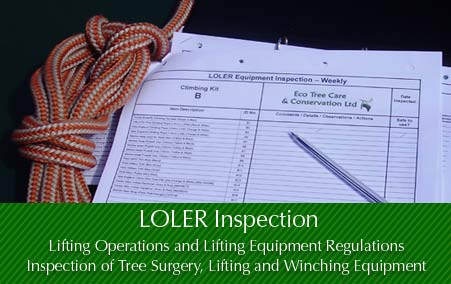
Note: This is an historical page and was believed to be correct and current until April 2013. The business is no longer operating and therefore this page is no longer being updated. The website remains for historical portfolio purposes and for information and interest.
The following are Eco Tree Care and Conservatrion Ltd notes on LOLER inspections for tree surgery equipment. These are provided for interest and information only. We do not provide independant LOLER inspections ourselves.
LOLER inspection
LOLER stands for “Lifting Operations and Lifting Equipment Regulations”. These regulations came into force on 5 December 1998.
See the General LOLER HSE Document for more information, also LOLER: How the Regulations apply to Tree Surgery - Arboriculture
The legislation was brought in to ensure that any equipment used for lifting or lowering is...
![]() strong and stable enough for the particular use
and marked to indicate safe working loads
strong and stable enough for the particular use
and marked to indicate safe working loads
![]() positioned and installed to minimise any risks
positioned and installed to minimise any risks
![]() used safely, i.e. the work is planned, organised
and performed by competent people
used safely, i.e. the work is planned, organised
and performed by competent people
![]() subject to ongoing thorough examination and, where
appropriate,
subject to ongoing thorough examination and, where
appropriate,
inspection by competent people
LOLER links in with other health and safety legislation i.e. with the Management of Health and Safety at Work Regulations 1999 (MHSWR)
The MHSWR require a risk assessment to be carried out to identify the nature and level of the risks associated with a lifting operation.
Factors to consider include...
![]() the type of load being lifted
the type of load being lifted
![]() the risk of the load falling and striking a person
the risk of the load falling and striking a person
![]() the risk of the lifting equipment striking a person
the risk of the lifting equipment striking a person
![]() the risk of the lifting equipment failing or falling
over in use
the risk of the lifting equipment failing or falling
over in use
LOLER Inspections of Tree Surgery (Arboricultural) Equipment
Independant LOLER Inspections
Tree Surgery 'Climbing' Equipment must, by law, be subjected to a through independant examination every 6 months. This covers all equipment that is involved where people are being lifted or are using it to climb. For lifting gear used in tree surgery operations, such as lowering equipment and rigging equipment this is subject, legally, to a 12 month independant LOLER inspection.
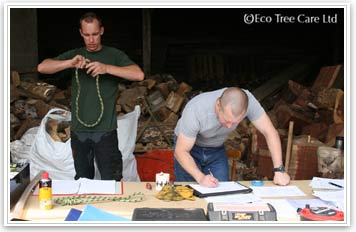 There
is also a requirement to have the equipment checked
for safety if there is an 'exceptional circumstance'
which may have compromised the safety of the equipment.
There
is also a requirement to have the equipment checked
for safety if there is an 'exceptional circumstance'
which may have compromised the safety of the equipment.
A competent person is someone
who can show they have the 'appropriate theoretical
knowledge and experience to enable them to detect
defects and weaknesses in the equipment'.
This is recognised as someone who has attended a
recognised course and achieved certification for
LOLER inspection.
This should be someone specifically trained to inspect arboricultural equipment and who has a working knowledge of the tree surgery industry and tree climbing. They must also be totally independant and able to act with out "fear or favour". Tree surgery equipment is expensive and so condeming it, by taking it out of action because it is potentially unsafe, can be quite a financial hit to the owner. Therefore there is the potential for a conflict of interests.
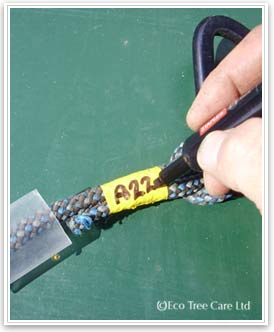
LOLER requires accurate records to be kept itemising each and every component and identifying it with a unique mark.
The LOLER inspector will issue a written record of each item checked and anything removed from service.
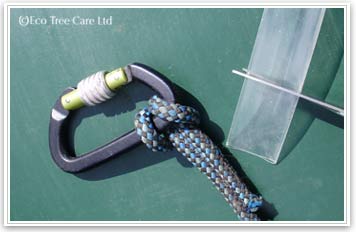
Use heatshrink to seal the marked numbers.
There are systems on the market for tree surgery companies with a large inventory of equipment that employ bar codes or electronic tags. This allows equipment to be quickly identified and the record updated electronically in one go.
In-house LOLER Inspections
As well as the half yearly independant LOLER check there is legal requirement to have a weekly in-house check of the arb climbing and lowering equipment. This must be properly recorded and again must be done with the mind set of "without fear or favour". It is usual and recommended, some would say essential, that each climber has a dedicated climbing kit that they look after and they inspect for themselves. The in-house checks should be carried out by persons holding tree surgey climbing qualification NPTC CS38 - Climb Trees and Perform Aerial Rescue. The thorough inspection of arb climbing equipment to LOLER standards is part of the training and assessment.
On top of all these formal and written inspections the climber should always give their equipment a once over before they start climbing, maintain awareness of it during the working day, and inspect it again as they are putting it away. It is basic common sense and with practice becomes quick and second nature.
Over-engineering
As a general rule it is said that fabric tree surgery equipment (ropes, harnesses, strops e.t.c.) are ten times over-engineered i.e. They should be able to withstand loading of x 10 the stated rating.
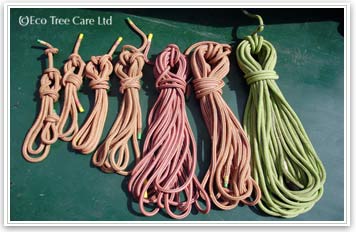
Metal items (e.g. karabiners, maillons, grillons)
are said to be five times over engineered.
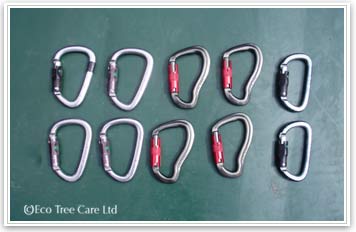
This is not something to be used
in LOLER calculations or in assessment of risk as
it is a very general and unqualified statement.
However it is included here for interest and it
also serves to give a broader understanding what
may be classed as an ‘exceptional circumstance’
e.g. in the case of a severe shock load.
Age of Tree Surgery Equipment
There are general guidelines on the age of tree surgery equipment in service. However the LOLER inspectors role is to ensure that equipment is safe to use for its intended purpose, therefore if a harness or a rope is in good condition having seen little use then discretion can allow for it to remain in service longer than the guidelines.
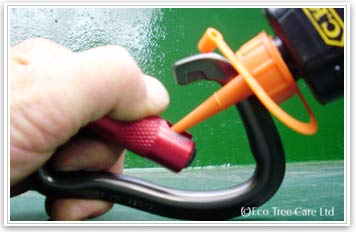
Old equipment can be kept in service by good maintenance and repair practices. It is quite acceptable to clean and lubricate a sticking karabiner lock so it is working consitently.
Ropes can by shortened and re-sealed to cut out damaged sections (unless the damage is due to overloading). Likewise a harness can be returned to the manufacturers for re-stitching or repair.
Climbing Equipment for Tree Surgery Operations
Climbing Ropes
Climbing ropes must be uniquely identifiable – Our preference is to use coloured tape wrapped at one end with a unique identifier number. The Tape and rope is then sealed with clear heat-shrink and a heat gun.
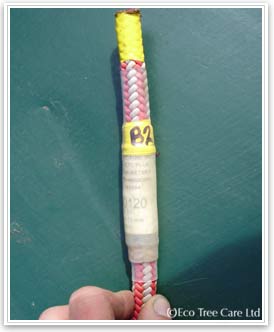
Keep all climbing ropes from coming into contact
with petrochemicals and solvents. Ropes should be
kept clean, preferably kept in a dedicated rope
bag.
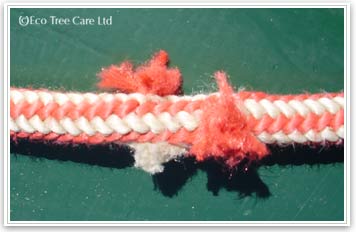
If more than 10% of the rope has worn then it is a fail
If there are 2 strands adjacent to each other damaged
or broken then it is a fail
If there are 3 strands along the entire length that
are damaged or broken then it is a fail
Ropes can be cut to remove the damaged section,
resulting in shorter ropes.
Ropes should be cut and the ends sealed with a hot
knife.
Age of ropes
Shelf life of new climbing ropes is 10 years
Age limit on climbing ropes in use is 5 years
Climbing ropes must only be used for tree climbing
and never to be used for lowering or pulling
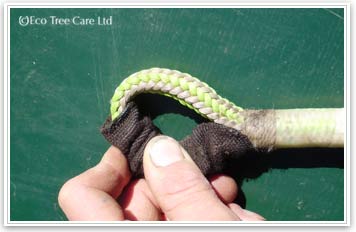
If the rope has a sewn eye at the end then this must be inspected carefully.
If the eye has a protective sleeve then this must be pushed or pulled out of the way to enable the entire loop to be inspected thoroughly.
Eyes should only be sewn by professional rope manufacturers.
Harnesses
Check all the stitching on load bearing points.
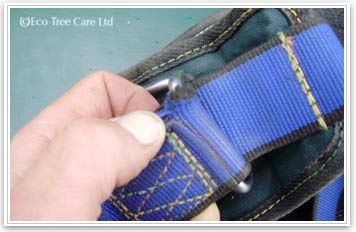
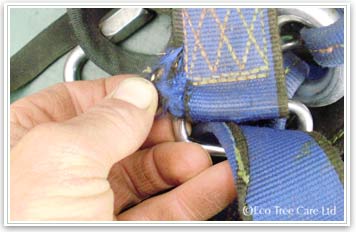
The photo above right shows a climbing harness that has an area of concern. However it is just minor fraying. It is fine it just needs tidying up by cutting off the fray and using a lighter to gentle seal the fibres. Record any actions taken.
Fail if any damage is over 10% of the width.
Work systematically over and around whole harness
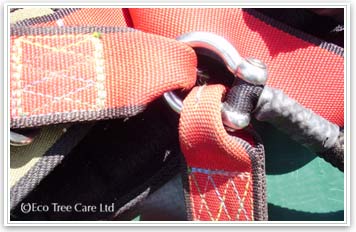
Check the harnesses metalwork.
Check the sliding D ring if present.
Check any maillons.
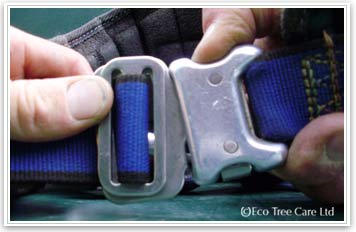
Check the clips that do up the harness waist belt and the leg loops.
Ensure that they only open when both buttons are
depressed.
Try depressing one only in turn to test the clips.
Harnesses must be individually
numbered and identifiable.
Lifetime of harnesses is typically 5 years as other
fabric items.
Grillons, Lanyards and Climbing Strops
The lanyard rope can be bought separately and can be replaced when necessary e.g. Beale – Antipodes.
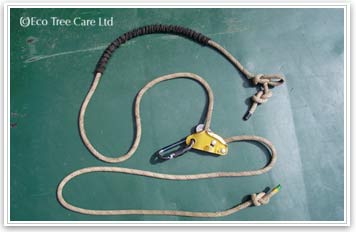
If a length of suitable rope is used then a fishermans
knot can be used to tie it to the karabiner. A stopper
knot must be tied in the end.
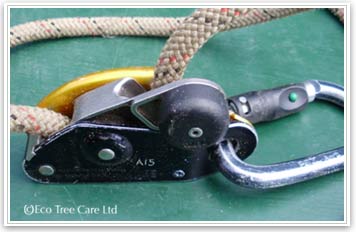
The metal Grillon has a life time of 3 years, the
rope is subject to the same checks ands specification
as climbing ropes.
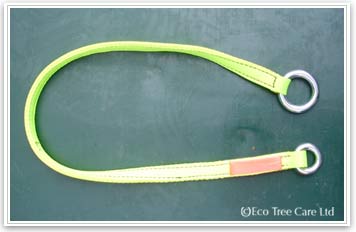
Cambium Savers are part of the climbing system and must be submitted to the same rigourous inspection.
Prussik loops
Rope for prussik loops must be ‘friction rope’. Rock climbing rope is not suitable as it is not heat resistant.
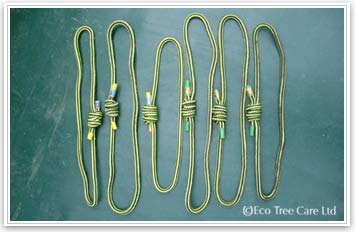
Prussiks can be made from 10mm rope – Beale
Regate is suggested (Length required 145 –
150cm)
Avoid Marlow Wasp as this has been known to melt
when movement over the rope has been fast
When tying use a double fishermans knot.The tail
need to be twice the size of the rope.
Do not tape up the tails.
Each prussik loops needs to be marked in the same
manner as the climbing ropes
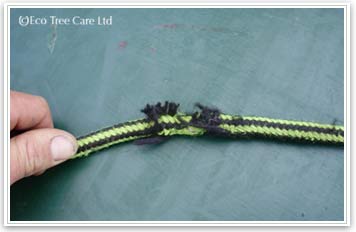
Check for 10% wear = fail
Check for glazing on the inside of the loops
Check for any ‘memory’ in the loops
Steelcore Strops
The outer sheath is for friction and should be intact.
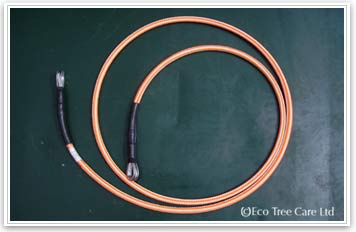
If the outer is still useable then it is still ok.
Check that the ends of the sheath are intact and
not coming away.
Climbing Karabiners
Only use 3 way karabiners within
the climbing system
Check the closing action, try really hard to get
the locking gate to stick open
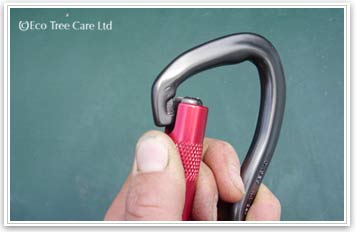
Run fingers all over the metal to feel for any nicks
or sharp bits. Smooth of any with ‘wet &
dry’ paper. Sharp bits could damage climbing
ropes or harness.
Wear rule is 10%.
Do not put karabiners straight onto sliding harness
strops, use a maillon in between. Grit on the sliding
strop can wear away at the karabiner.
The karabiner can be engraved on the spine or on
the barrel with an engraving tool and should be
uniquely identified.
Aluminium Karabiners are used for tree climbing
& tree surgery. Steel karabiners are used for
rigging
Two way karabiners can be used for attaching chainsaw
to strop and chainsaw strop to harness.
Chainsaw strops
Chainsaw strops are also covered under LOLER (The legislation applies when a person or something else dangles off a rope)
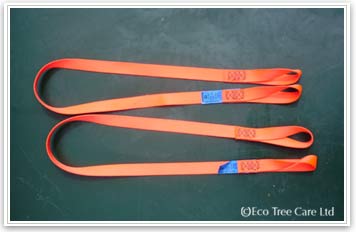
Saw strops should not be home made as there are
items specifically made for the purpose. Professionally
made saw strops will have a stitching that will
intentionally fail in case of an emergency e.g.
if the saw is taken by a branch out of the tree
whilst back cutting.
The same checks should be made as for climbing ropes
and prussik loops
Climbing Kit Inspection
Climbing equipment (anything
used in the climbing system) should be visually
inspected prior to each and every use
Climbing equipment should be subjected to a weekly
in-house LOLER inspection. There must be a written
record kept of these inspections.
Climbing equipment should undergo a LOLER inspection
by a independent and qualified LOLER inspector every
6 months
A note about aerial rescue kits
For aerial rescue purposes there should always be a 2nd climbing kit on site. It has been suggested that this should be an actively used climbing kit rather than one reserved specially for aerial rescue.
In the case of emergency the person performing the aerial rescue will be much more effective if the equipment used is familiar and used regularly.
Rigging Equipment for Tree Surgery Operations
Pulleys
Pulleys in the rigging kit should only be used for
setting up 3-way pulls e.t.c.
Pulleys are not designed for ‘shock’
lowering use blocks
There is no year rating as for karabiners
Checks should be to ensure that there are no defects
or damage
Blocks
Check that there are no sharp edges.
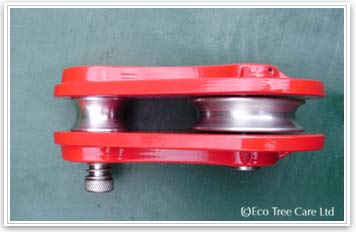
Ensure that the locking mechnism is smooth and closes correctly.
Rigging Karabiners
Check the closing action, try really hard to get
the locking gate to stick open
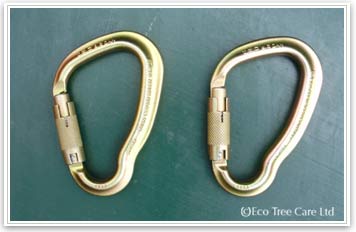
Run fingers all over the metal to feel for any nicks
or sharp bits. Smooth of any with ‘wet &
dry’ paper. Sharp bits could damage ropes
Wear rule is 10%
The karabiner can be engraved on the spine or on
the barrel with an engraving tool and should be
uniquely identified
Aluminium Karabiners are used for climbing. Steel
karabiners are used for rigging Lowering ropes
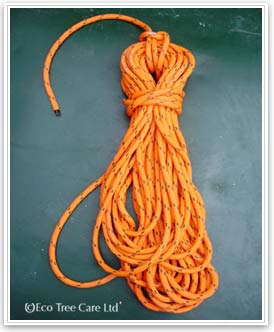
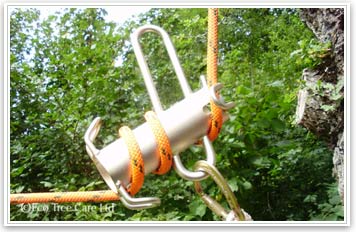
Lowering ropes should be low stretch with high strength.
Old climbing ropes can not be used as lowering ropes,
however they can be used as pulling ropes
Rigging Equipment Inspection
Rigging equipment should be visually inspected prior
to each and every use.
Rigging equipment should be subjected to a monthly
in-house LOLER inspection. There must be a written
record kept of these inspections.
Rigging equipment should undergo a LOLER inspection
by a independent and qualified LOLER inspector every
12 months.
Failed Equipment
Ensure that equipment that has failed is permanently taken out of action i.e. cut prussik loops, strops e.t.c.
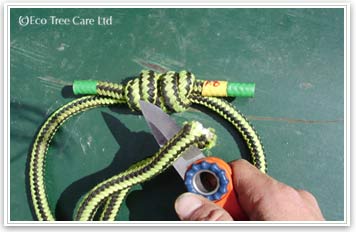
Disclaimer:
This document is to serve as information and guidance
only and may be subject to updating & changes.
It may contain errors and omissions.
DO NOT base LOLER inspections or tree surgery equipment
inspections solely on these notes.
Instead contact a qualified LOLER tree surgery equipment
inspector for definitive answers and have you arboricultural
equipment inspected by them.
Consult the HSE documentation and legislation and contact them as necessary.
You alone are responsible for the safety of your tree surgery equipment.

